
As a lefty liberal, I like Michael Moore. As a journalist (I have more creds than just a blog, I swear), not so much. Lucky for me he's making movies for the masses and not writing for
The Washington Post. Otherwise, he'd have been shut down years ago. Instead, we can enjoy his films for what they are - films that while maybe not full of "truthiness" will make people talk and think.
As Moore state in the film,
SiCKO is not actually about people who don't have health care in America. It's more about people who DO have health insurance and get screwed by it. People who pay the premiums and deductibles and still get denied care. In America, we like to get what we pay for, but when it comes to insurance it doesn't seem to work that way.
He tells the stories of an older couple who have gone bankrupt paying for medical treatment for heart attacks and cancer, even though they have good jobs with good insurance. The middle-aged woman who's brain tumor was considered not a medical emergency and died. The young woman who's surgery was paid for by her insurance and then payment was revoked when it was revealed that she had not disclosed a previous yeast infection when applying for insurance.
Moore reports in the movie that he received over 2500 emails from people with stories about the horrors of health insurance - many of them from people who work in the insurance industry. The most stand-out story was that of Linda Peno, a former medical reviewer (the person in charge of deciding who gets what care) for the Humana HMO. Ms. Peno stated in a congressional review:
I wish to begin by making a public confession. In the spring of 1987, I caused the death of a man. Although this was known to many people, I have not been taken before any court of law or called to account for this in any professional or public forum. In fact, just the opposite occurred. I was rewarded for this. It brought me an improved reputation in my job and contributed to my advancement afterwards. Not only did I demonstrate that I could do what was asked, expected of me, I exemplified the good company employee. I saved a half a million dollars.
It may be no secret that insurance companies are for-profit businesses and saving money is their game. After all, we're a capitalist society. But is this the right way to go? Moore points out our socialized fire and police protection. Our free schools. Free libraries. Why not free, government-controlled health care?
Most are quick to point out Canada's socialized medicine and how it's just...bad. Long wait times to see doctors and get procedures done. Sub-par professionals and facilities. In the movie, Moore visits some Canadians and speaks with them about their speed and quality of care. The Canadians he spoke with were happy with both. He also spoke with British and French people about their socialized medicine and American ex-pats in England and France about their care. All of those countries got glowing reviews.
Of course, this is the sort of thing one sees in a Moore movie that one might need to take with a grain of salt. Is the Canadian health system really as good as Moore would have us believe? When every review is glowing one has got to assume there were several opinions left on the cutting-room floor.
Two examples of rebuttals for this film come from
The Associated Press and
Kurt Loder of MTV News. The AP article is sort of rubbish - while it points out that Moore inflates numbers a bit in the film (reporting 50 million uninsured in the U.S. as opposed to 44.8 million, for example) when you're dealing in millions of lives the rebuttal is sort of moot. Whether it's 50 million or 44.8 million uninsured, or $800 million given to health insurance companies from a Medicare bill or $729 million...it's all still too much.
Moore also points out that American is 37th in the world in terms of health care. The AP points out that Canada is 30th. Loder is quick to point out flaws in the Canadian and French systems.
It doesn't matter what rank Canada has or how French is bungling their medicine. When it comes to actual health care resources, America is top-notch. Doctors come
here to train and dignitaries come
here for procedures. Unlike Ottowa's "one chemo machine," the American health care infrastructure is in place. Moreover, since we're the last modern western country to delve in to socialized medicine we're able to assess all other failed and successful systems and create one to meet our needs.
But can we? Will we? Can we afford it? For my small company, it costs roughly $800/mo to insure one family of three and about $200/mo to insure a single person. This is before any out-of-pocket costs, of course (one employee reports having to pay about $5000 out-of-pocket in 2006 when his family of 2 became a family of 3). The auto industry is crumbling largely in part to the increasing cost of health care for current and retired employees. People are paying for health care in one form or another, so why not alleviate those personal and industry costs and put the money towards a more greater and fair use? One of the interviewees (from England) in Moore's movie makes a seriously strong point - if the government can find money to kill people, why can't it find money to help people? If it costs my company an extra $300 per month in taxes instead of $200 a month in premiums to keep me insured under a government plan and I am guaranteed never to be denied any health care, how could I argue with that?
We've all got tales of being screwed by health insurance. I was lucky enough to be brought up under one of America's best health insurance plans as the child of a union auto worker. I never had to fight for any sort of care. But, when I was 18 (still under my dad's insurance as I was in college), I was diagnosed with Temporal Mandibular Joint Disorder (TMJD). Before I got treatment, I was to the point where I had to drink my dinner through a straw because I couldn't open my mouth wide enough or have the power to chew. TMJD treatment, which can be long and expensive whether you have it surgically corrected or corrected through orthodontics, is not covered under most health insurance including mine. Lucky for me, my college fund was supplemented with scholarships and my folks were financially well-off to just bite the bullet and pay for treatment. I was extremely lucky to have been diagnosed at the right time in my life. Had it happened today, no matter what my health insurance status, I'd have been in serious, serious debt.
As everyone grows and goes through the working world, we are all in fear of losing health care or losing health. This is our future and it seems hopeless.
SiCKO points out that in other countries, government fears the people while in America the people fear the government. In America we're strapped by debt and fear of not being able to get or stay healthy. We're apathetic and scared and we don't vote. We don't discuss. We don't rebel.
SiCKO will hopefully turn American thought and discussion back from a losing war in the Middle East to the very real and very domestic problem of American health care reform. Moore's ideas and presentations might not serve as a good template for what can or should be done but
SiCKO is definitely a movie worth seeing and hopefully starts the ball rolling on discussions about what can be done.
 As a lefty liberal, I like Michael Moore. As a journalist (I have more creds than just a blog, I swear), not so much. Lucky for me he's making movies for the masses and not writing for The Washington Post. Otherwise, he'd have been shut down years ago. Instead, we can enjoy his films for what they are - films that while maybe not full of "truthiness" will make people talk and think.
As Moore state in the film, SiCKO is not actually about people who don't have health care in America. It's more about people who DO have health insurance and get screwed by it. People who pay the premiums and deductibles and still get denied care. In America, we like to get what we pay for, but when it comes to insurance it doesn't seem to work that way.
He tells the stories of an older couple who have gone bankrupt paying for medical treatment for heart attacks and cancer, even though they have good jobs with good insurance. The middle-aged woman who's brain tumor was considered not a medical emergency and died. The young woman who's surgery was paid for by her insurance and then payment was revoked when it was revealed that she had not disclosed a previous yeast infection when applying for insurance.
Moore reports in the movie that he received over 2500 emails from people with stories about the horrors of health insurance - many of them from people who work in the insurance industry. The most stand-out story was that of Linda Peno, a former medical reviewer (the person in charge of deciding who gets what care) for the Humana HMO. Ms. Peno stated in a congressional review:
As a lefty liberal, I like Michael Moore. As a journalist (I have more creds than just a blog, I swear), not so much. Lucky for me he's making movies for the masses and not writing for The Washington Post. Otherwise, he'd have been shut down years ago. Instead, we can enjoy his films for what they are - films that while maybe not full of "truthiness" will make people talk and think.
As Moore state in the film, SiCKO is not actually about people who don't have health care in America. It's more about people who DO have health insurance and get screwed by it. People who pay the premiums and deductibles and still get denied care. In America, we like to get what we pay for, but when it comes to insurance it doesn't seem to work that way.
He tells the stories of an older couple who have gone bankrupt paying for medical treatment for heart attacks and cancer, even though they have good jobs with good insurance. The middle-aged woman who's brain tumor was considered not a medical emergency and died. The young woman who's surgery was paid for by her insurance and then payment was revoked when it was revealed that she had not disclosed a previous yeast infection when applying for insurance.
Moore reports in the movie that he received over 2500 emails from people with stories about the horrors of health insurance - many of them from people who work in the insurance industry. The most stand-out story was that of Linda Peno, a former medical reviewer (the person in charge of deciding who gets what care) for the Humana HMO. Ms. Peno stated in a congressional review:
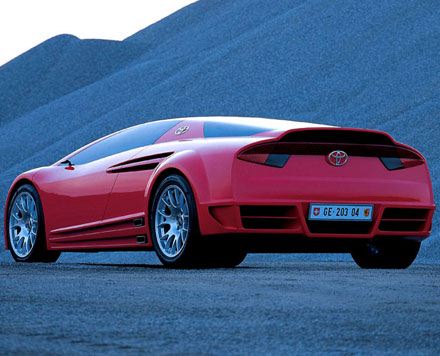 This car looks like it could go very very fast. It also looks like the maximum height you could possibly be to drive in this vehicle is 5'5" and that is pushing the limit. I don't know if this is the fastest electric hybrid on the market but with dual electric engines (one for each front tire) this car boasts that it has a 408 horsepower hybrid engine, the safety of all-wheel drive and can do 0-60 in just four seconds. Look at those desert dunes. This car is ready to climb them, but I am a little worried that the hills are too steep and those don't really look like tires that get the best traction. So, maybe it's not good to drive in the desert, but since no one really off roads their vehicles like they do in the commercials, I think this car might be OK.Second Place goes to GM Saab Aero X:
This car looks like it could go very very fast. It also looks like the maximum height you could possibly be to drive in this vehicle is 5'5" and that is pushing the limit. I don't know if this is the fastest electric hybrid on the market but with dual electric engines (one for each front tire) this car boasts that it has a 408 horsepower hybrid engine, the safety of all-wheel drive and can do 0-60 in just four seconds. Look at those desert dunes. This car is ready to climb them, but I am a little worried that the hills are too steep and those don't really look like tires that get the best traction. So, maybe it's not good to drive in the desert, but since no one really off roads their vehicles like they do in the commercials, I think this car might be OK.Second Place goes to GM Saab Aero X:
 How cool is this car? It's totally like a Back to the Future kind of futuristic car. Very nice, looks sleek but the only problem I visibly see with this vehicle is this: what happens when you lock your keys in the car? I really don't think the tow truck operator is going to be able to jimmy this particular vehicle. Well, I guess that is good b/c no one can steal your car that way but think about this, what are you going to do if the "door" stops working? I don't think climbing into the trunk is a viable option, either. This is cool, too: " the Saab Aero X's cockpit completely eliminating conventional dials and buttons. Instead, Saab displays data on glass-like acrylic "clear zones" in graphic 3-D images." Very futuristic. It has a 400 horse powered engine that runs completely off of ethanol. Over all this is the car of the future, as soon as we figure out how to open the door.
And in first place in the "cool kids" category goes to the Honda FCX ConceptÂ
How cool is this car? It's totally like a Back to the Future kind of futuristic car. Very nice, looks sleek but the only problem I visibly see with this vehicle is this: what happens when you lock your keys in the car? I really don't think the tow truck operator is going to be able to jimmy this particular vehicle. Well, I guess that is good b/c no one can steal your car that way but think about this, what are you going to do if the "door" stops working? I don't think climbing into the trunk is a viable option, either. This is cool, too: " the Saab Aero X's cockpit completely eliminating conventional dials and buttons. Instead, Saab displays data on glass-like acrylic "clear zones" in graphic 3-D images." Very futuristic. It has a 400 horse powered engine that runs completely off of ethanol. Over all this is the car of the future, as soon as we figure out how to open the door.
And in first place in the "cool kids" category goes to the Honda FCX ConceptÂ
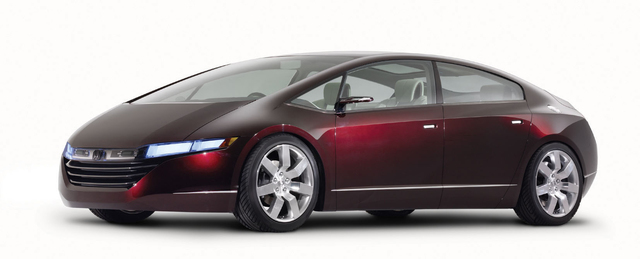 Look how shiny and aerodynamic. Look how many seats it has (prob the most in this category). It also employs a concept call vertical gas flow, meaning that the car uses gravity to help it conserve energy and make it's fuel cells more productive and helps this vehicle to improve the fuel cell storage space to allow for a much roomier car. "With these improvements, the FCX fuel-cell car now has a driving range of 354 miles—a 30 percent improvement from the 2005 model—and a maximum speed of 100 miles per hour" Not too bad, if I do say so myself.
Over all, I am very pleased to see that American car companies are taking the right step towards hybrid technology.  Hopefully we see continued competition to create more and more efficient and environmentally happy vehicles for public consumption without detrimental impact on consumer wallets.
Look how shiny and aerodynamic. Look how many seats it has (prob the most in this category). It also employs a concept call vertical gas flow, meaning that the car uses gravity to help it conserve energy and make it's fuel cells more productive and helps this vehicle to improve the fuel cell storage space to allow for a much roomier car. "With these improvements, the FCX fuel-cell car now has a driving range of 354 miles—a 30 percent improvement from the 2005 model—and a maximum speed of 100 miles per hour" Not too bad, if I do say so myself.
Over all, I am very pleased to see that American car companies are taking the right step towards hybrid technology.  Hopefully we see continued competition to create more and more efficient and environmentally happy vehicles for public consumption without detrimental impact on consumer wallets.
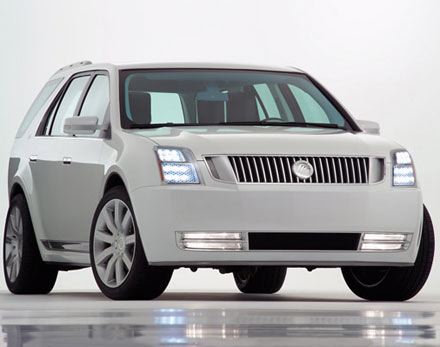 You may argue that this car isn't necessarily the ugliest car you have ever seen, in fact it's okay. Work with me here for a minute, if you please. Think back to that movie about the cars that try to kill people. You know the one, the really bad Stephen King movie,
You may argue that this car isn't necessarily the ugliest car you have ever seen, in fact it's okay. Work with me here for a minute, if you please. Think back to that movie about the cars that try to kill people. You know the one, the really bad Stephen King movie, 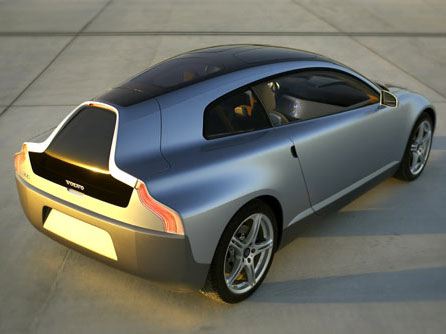 This vehicle is kind of ugly. I mean, it's nice and aerodynamic and boasts that it can run on any type of power system (gas, ethanol, hybrid or electric). But, it looks kind of...lame. Like the vision of the future that they had in the seventies where the high fashion of the times happens to be tunics and tennis skirts. And it only sits three people and quite uncomfortably, if you really look at it. And it also takes 10,000 lithium-ion batteries (like the ones in your lap top) to power. Only 10,000? That's nothing.
First place goes hands down to the Nissan Pivo for obvious reasons:
This vehicle is kind of ugly. I mean, it's nice and aerodynamic and boasts that it can run on any type of power system (gas, ethanol, hybrid or electric). But, it looks kind of...lame. Like the vision of the future that they had in the seventies where the high fashion of the times happens to be tunics and tennis skirts. And it only sits three people and quite uncomfortably, if you really look at it. And it also takes 10,000 lithium-ion batteries (like the ones in your lap top) to power. Only 10,000? That's nothing.
First place goes hands down to the Nissan Pivo for obvious reasons:
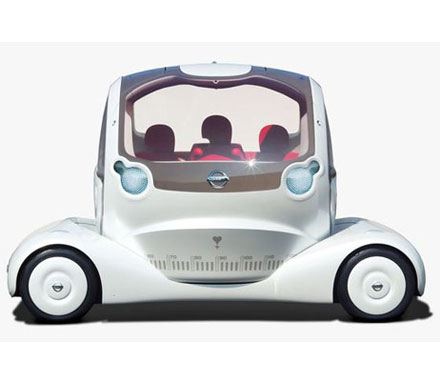 It's electric and it swivels. Enough said.
Eventually I will get around to posting the best of these concept cars. Thanks for reading!
It's electric and it swivels. Enough said.
Eventually I will get around to posting the best of these concept cars. Thanks for reading!